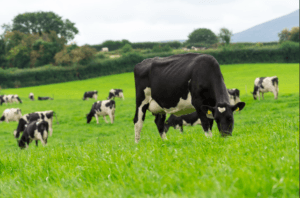Get a 24 hour weather forecast

The ultimate goals from early lactation nutrition are :
Success in all 3 is influenced by breeding and feeding. Success in all 3 will drive profitability and sustainability on your farm.
Breeding your cow for early lactation success:
Your cows need the genetic potential to succeed in all 3. When feeding our cows we present the cow with nutrients, it’s the cows genetics that decide what she will do with them. Will she push out more milk or will she mind her body condition. Your herds EBI and the balance of the sub-indexes for fertility and production ultimately decide.
Feeding your cow for early lactation success:
The main focus for all 3 should be energy nutrition. Feed your cows the best quality forages. The higher the DMD grass silages the better, grass, when possible, when the weather works with us. And feeding a balanced level of concentrates with that base forage.
A cow milking 23 litres will need 16 ufls but a cow milking 30ltrs will need 20% more energy of 19 ufls. To meet those requirements a cow consumes energy in forages and concentrates. The more energy contained within your forage source the less concentrates that are needed to meet a cows energy requirement.
For the average cow that’s going to peak at 25 litres on the average silage, 68 DMD, your cows will need 8kg of concentrates to meet her energy demand. Grass would typically be 20% higher in energy than silage. If you get your cows out for 6 hours you can drop your concentrate feeding but not dramatically. 6 kg of grass will save you c.1.5kg of concentrates, meaning that 25ltr cow still requires 6.5kg of concentrates. The more grass you get in the more concentrates you can drop out. It is possible to get higher grass intake into cows allowed c.4 hours grazing, but a specific on-off grazing plan must be implemented.
How do I know if I’m giving my cows enough energy?
Your milk bulk tank offers you great insights into your herds energy status:
1: Low Milk Proteins in early lactation is a sign your concentrate feeding level is not in balance with your base forage and the milk yield of your herd.
If your protein is low or your butterfat to protein ratio is high your cows are low in energy:
8kg of concentrates is a lot, what is the reason for this level of concentrates?
A cow is not aware of the weather or milk price. She has nutritional need based on her production level. 8kg is tip of the iceberg, it should be targeted to when its needed and fit into an overall yearly plan.
This spring has been wet and we’ve fed very little grass to date, so without a doubt our spring feeding is more costly, but will it amount to much over the year? Below I’ve costed a typical spring feeding plan versus this years.
Both springs are 14 weeks in duration, this year I’ve costed 2 months at 8kg with cows going straight out to grass (once the weather breaks). This years spring feeding plan will cost 0.8c/litre more than the standard spring.
With fertility, yearly protein and volume hugely influence by it, 0.8c/litre could be a wise investment.
| Concentrate feeding level | Length of the period, typical year | Total concentrates for the period (kg) | Length of the period, wet spring year | Total concentrates for the period (kg) | ||
| Indoors on 68 DMD silage | 8kg | 3 weeks | 168kg | 8 weeks | 448kg | |
| Out by day (6hrs) | 6kg | 3 weeks | 126kg | |||
| Grazing full time | 2.5kg | 8 weeks | 140kg | 6 weeks | 105kg | |
| Total | 434kg | 553kg | ||||
| Cost c/ltr (spring nutrition plan) | 2.8 c/ltr | 3.6c/ltr | ||||